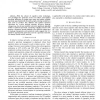Free Online Productivity Tools
i2Speak
i2Symbol
i2OCR
iTex2Img
iWeb2Print
iWeb2Shot
i2Type
iPdf2Split
iPdf2Merge
i2Bopomofo
i2Arabic
i2Style
i2Image
i2PDF
iLatex2Rtf
Sci2ools
VTC
2007
IEEE
2007
IEEE
FSMA - A Topology-Transparent Scheme for Opportunistic Spectrum Access
— With the advent of cognitive radio technology, new paradigms for spectrum access can achieve near-optimal spectrum utilization by letting users sense and utilize available spectrum opportunistically. Recently, graph-coloring models have been used to produce fair, efficient and optimal spectrum allocations for a given network topology. However, topology changes (e.g., due to user mobility) can incur significant signaling traffic to reallocate spectrum, consuming valuable resources. We propose a frequency-spread multiple access (FSMA) scheme that is topology-transparent, and numerical results suggest that it is suited for opportunistic spectrum access in a sparsely-connected, low-density mobile ad-hoc network.
| Added | 04 Jun 2010 |
| Updated | 04 Jun 2010 |
| Type | Conference |
| Year | 2007 |
| Where | VTC |
| Authors | Hwee Pink Tan, Colman O'Sullivan, Linda Doyle |
Comments (0)

